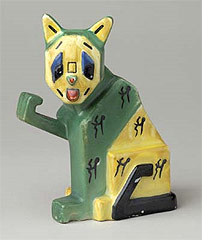
| HOME |
| NERVE |
| REVIEWS |
| ARCHIVE |
| EVENTS |
| LINKS |
| ABOUT US |
| CONTRIBUTORS |
| BACK ISSUES |
| CONTACT US |
 Age of
Jazz: British Art Deco Ceramics
Age of
Jazz: British Art Deco Ceramics
The Walker Art Gallery
10th June - 30th October 2005
Reviewed by Adam Ford
If you stopped a hundred people in the street and asked them what they
associated with the ‘age of jazz’, what would they come up
with? Speakeasies? Louis Armstrong? Duke Ellington? Unless they’ve
been to the Walker recently, are they really going to say ‘art deco
ceramics’? Our survey says….well, probably not actually old
chap.
But in the parallel universe that is this exhibition space, the age of
jazz is solely known for a buttoned-up culture of the white upper and
middle classes, who apparently bought porcelain cats to distract themselves
from the tumult of the world around them. Even the few miniature jazz
figurines are white.
On entry, the viewer is confronted by a mock-up of a genteel living room, so you can see where all the bits and bobs went. The lounge looks ideal for entertaining low-rent Nazis, and you can almost see Lord or Lady Muck pouring our friendly fascist a cup of tea from an ‘exquisite’ pot, before offering him a scone from a perfectly-formed but characterless china plate.
Admittedly, art deco isn’t my specialist subject, but now I know why I’ve never looked into it. Popular during the 1920s and early 1930s, it was meant to be the perfect synthesis of the ‘artistic’ and ‘decorative’. Unfortunately, it seemed like neither to my untrained eye.
Ok, so you like fruit and flowers. Don’t blame you, nature is a beautiful and amazing thing and all that. But don’t debase it by putting horribly pale imitations all over your crockery. So you went to Africa and saw some mysterious face masks. Don’t ruin them by just commissioning a mask of your sister’s best friend. And how many times can you nip out to paint your mistress without the wife minding?
Don’t get me wrong, I can appreciate ceramics as much as I can any art. But I can only appreciate art when it is crafted with affection by someone who loves what they are doing. Most of the items on display fell uncomfortably between the snootily showy and the unexceptional mass-produced numbers.
Maybe I’m a cynic, but the whole showcase seemed neatly summed-up
by a caption under one particularly nasty plate. I kid you not, it actually
read: ‘This pattern would have been cheerful to use at the tea table
during the dark days of the Depression’. Well…maybe. If you
had something to put on it.